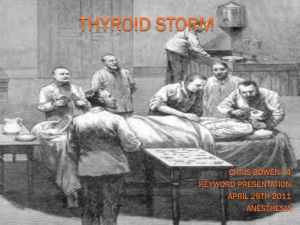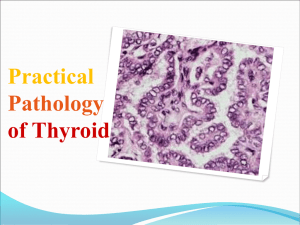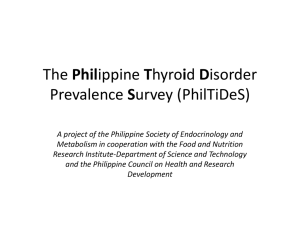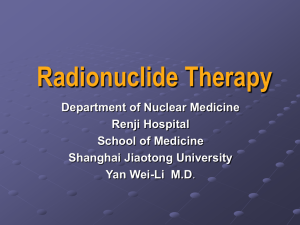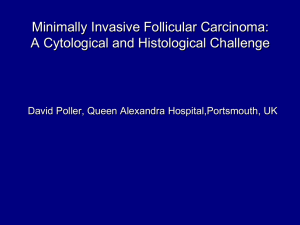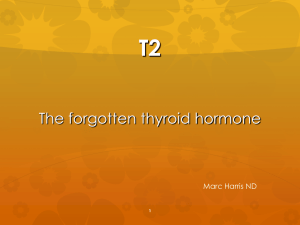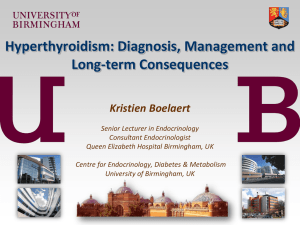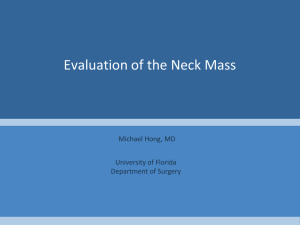Nuclear Thyroidology
advertisement
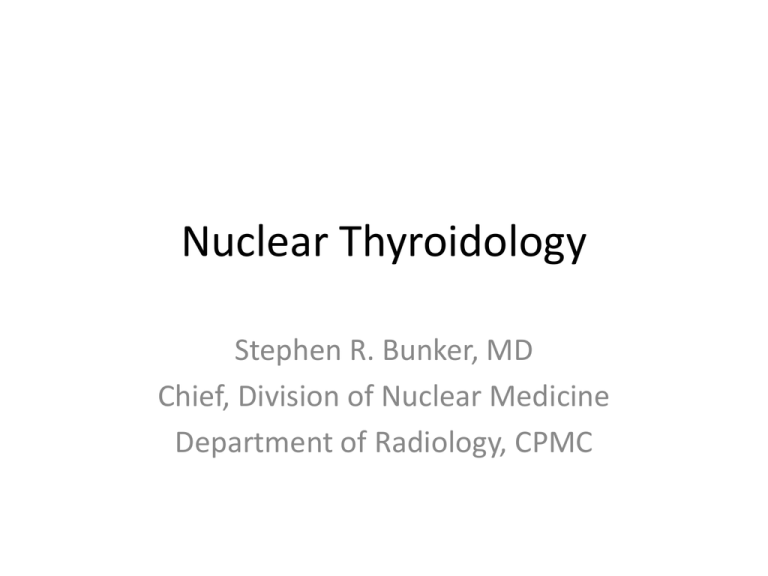
Nuclear Thyroidology Stephen R. Bunker, MD Chief, Division of Nuclear Medicine Department of Radiology, CPMC Radioactive Iodine is a b-emitting radionuclide with a physical half-life of 8.1 d; a principal g-ray of 364 keV; and a principal b-particle with a maximum energy of 0.61 MeV, an average energy of 0.192 MeV, and a mean range in tissue of 0.4 mm. 131I Radioiodine Therapy Oral administration of 131I as sodium iodide to treat papillary and follicular thyroid cancer, hyperthyroidism, or nontoxic nodular goiter (in contrast to the diagnostic use of radioiodine to detect functioning thyroid tissue). Radioiodine Therapy Benign diseases include: Graves disease (toxic diffuse goiter) and toxic or nontoxic nodular goiter. Malignant diseases include: papillary and follicular types of thyroid cancer that are sufficiently differentiated to be able to synthesize thyroglobulin and, in most cases, accumulate radioiodine. Ablation refers to the use of 131I to eliminate residual normal thyroid tissue detected after thyroidectomy. COMMON CLINICAL INDICATIONS Benign diseases: 1.Hyperthyroidism (131I may be indicated for the treatment of Graves disease and toxic nodular [uninodular or multinodular] 2.Nontoxic nodular goiter (131I therapy may be used successfully to diminish the size of nontoxic nodular goiters, especially when surgery is contraindicated or refused. Malignant disease: Differentiated papillary and follicular thyroid cancer (131I therapy is the principal treatment of residual thyroid tissue after thyroidectomy [thyroid remnant ablation], of residual or recurrent thyroid cancer, and of metastatic disease after neartotal thyroidectomy). Therapy of Graves disease toxic nodules, and nontoxic nodular goiter Goals: The goal of therapy for hyperthyroidism is to achieve a nonhyperthyroid status—either a euthyroid state or iatrogenic hypothyroidism that has been completely compensated to the euthyroid state with oral levothyroxine. The goal of therapy for a large nontoxic nodular goiter is the reduction of thyroid volume to relieve symptoms caused by compression of the goiter on structures in the neck. Therapy of Graves disease toxic nodules, and nontoxic nodular goiter Patient preparation: For a sufficient time before therapy, patients must discontinue use of iodide-containing medications and preparations that could potentially affect the ability of thyroid tissue to accumulate iodide (Table 1). Therapy of Graves disease toxic nodules, and nontoxic nodular goiter Patient preparation: Pretreatment of selected patients with thionamides (methimazole [Tapazole; Eli Lilly and Co.] or propylthiouracil) to deplete thyroid hormone stores may be helpful, although there must be awareness of uncommon adverse reactions to thionamides, including agranulocytosis and hepatotoxicity Therapy of Graves disease toxic nodules, and nontoxic nodular goiter Patient preparation: Thionamides 131I therapy can cause radiation-induced thyroiditis with release of stored thyroid hormone into the circulation, resulting in occasional transient worsening of hyperthyroidism and, rarely, precipitation of thyroid storm. This is more likely to occur in patients with a large, iodine-avid thyroid gland who are given higher activities of 131I. Accordingly, elderly patients and patients with significant preexisting heart disease, severe systemic illness, or debility may benefit from pretreatment with thionamides. Patient preparation: Thionamides The thionamide should be discontinued for 3–5 d before the radioiodine therapy is given (at CPMC, we prefer 7-10 days for the optimal rebound effect on radioactive iodine uptake [RAIU]) and can be resumed 2–3 d afterward. Some experts recommend administering a higher activity of 131I in patients who have been pretreated with a thionamide. Although some studies suggest that radioresistance is more likely with propylthiouracil than methimazole, the issue remains unsettled. A randomized study found no effect of pretreatment of Graves disease with methimazole on outcome. In another study, thionamides had no effect on the outcome of Graves disease, but the outcome of radioiodine therapy for toxic nodular goiter was adversely affected. Large goiters and severe hyperthyroidism may also be associated with radioresistance and require a higher 131I administered activity. Information for Patients 1. More than one 131I treatment may be necessary and that longterm follow-up is necessary, that recurrent laryngeal nerve palsy and dysgeusia (altered or distorted sense of taste) are very uncommon side effects, and that there is a small (1%–5%) chance of a mildly painful radiation thyroiditis after treatment but that acetaminophen or other nonnarcotic analgesic therapy usually suffices and corticosteroids are rarely required. 2. The likelihood of eventual hypothyroidism is high in Graves disease (at CPMC, this is actually the target of our RX, 90% likely in 2.5-3.0 months) and somewhat lower with nodular goiters. It can occur within the first few months after therapy or even decades later, with a small, ongoing annual incidence. Lifelong thyroid hormone supplementation would then become necessary Information for Patients 3. Ophthalmopathy may worsen or develop after 131I therapy for Graves’ disease, especially in smokers. High levels of pretreatment serum triiodothyronine, posttherapy hypothyroidism, and thyroidstimulating hormone (TSH) receptor antibody are also associated with an increased risk of the development or progression of ophthalmopathy. 4. Patients with severe hyperthyroidism may occasionally experience an exacerbation of symptoms within the first 2 wk after 131I therapy. These symptoms usually respond to short-term b-blocker therapy and a thionamide but rarely may progress to frank thyroid storm. Patients should be instructed to seek immediate medical care should such symptoms occur. Cancer Risk On the basis of previous multicenter trials, there is no evidence of an increased risk of thyroid carcinoma or other malignancy, an increased risk of infertility, or an increased incidence of birth defects caused by 131I therapy for hyperthyroidism. There does exist a small risk of preexisting or coexisting thyroid cancer in patients with toxic nodular goiter and Graves disease unrelated to 131I therapy. Pregnancy Most experts recommend waiting 6–12 mo after 131I therapy before trying to conceive a child (although there are no scientific data on the subject). At CPMC, we explain to patients that the greatest threat to a healthy pregnancy is thyroid hormone levels that are too high or too low. Accordingly, between 4 and 6 months is when euthyroidism post-radioiodine therapy is most often achieved, thus 4-6 months would be a range that prospective parents might consider conception. Pregnancy 131I therapy is always contraindicated in pregnant women. The fetal thyroid gland concentrates iodine by weeks 10–13. Female patients who have the potential to be pregnant must always be tested for pregnancy using a urine or serum b–human chorionic gonadotropin (hCG) test, ideally within 24 h of treatment, as the pregnancy test may remain negative for up to 7–10 d after fertilization. The urine b-hCG test can rarely detect hormone levels less than 20–25 mIU/mL, whereas serum testing is sensitive to 10 mIU/mL or lower. Caution is therefore advised in treating patients who have had unprotected intercourse in the 10 d before treatment, and the treating physician should consider discussing the limitation of the pregnancy test with the patient, which could include consideration of delaying the therapy until the beginning of the next cycle. Breast Feeding All potentially breastfeeding or lactating women must be asked if they are lactating. If so, they must be advised to stop breastfeeding, and therapy must be delayed until lactation ceases, in order to minimize the radiation dose to the breast. Lactation (and the ability of the breast to concentrate large amounts of iodine) usually ceases 4–6 wk after birth (with no breastfeeding) or 4–6 wk after breastfeeding stops. Documentation in the patient’s record that the patient denies breastfeeding is suggested. If there is uncertainty as to whether the previously lactating breasts still concentrate iodine, this may be assessed by noting the absence of uptake on pretherapy scintigraphy with 123I or 99mTc-pertechnetate. 131I therapy of thyroid cancer to ablate postthyroidectomy remnants and destroy residual or recurrent tumor 131I ablative or tumoricidal treatment of differentiated thyroid cancer should be considered in the postsurgical management of patients with a maximum tumor diameter greater than 1.0 cm or with a maximum tumor diameter less than 1.0 cm in the presence of high-risk features such as aggressive histology (Hurthle cell, insular, diffuse sclerosing, tall cell, columnar cell, trabecular, solid, and poorly differentiated subtypes of papillary carcinoma), lymphatic or vascular invasion, lymph node or distant metastases, multifocal disease, capsular invasion or penetration, perithyroidal soft-tissue involvement, or an elevated antithyroglobulin antibody level after thyroidectomy (so that scintigraphy can be used for surveillance). 131I therapy of thyroid cancer to ablate postthyroidectomy remnants and destroy residual or recurrent tumor The treatment of very low and low-risk thyroid cancers with 131I is controversial, as most data suggest no statistically significant improvements in disease-specific survival, although the recurrence rates may decrease. Because treatment choices depend, among other factors, on the pathology, location, and size of thyroid cancer, preablation staging must be considered. The presence or absence of iodine-accumulating thyroid tissue before ablation should be documented by uptake measurement and imaging. 131I therapy of thyroid cancer to ablate postthyroidectomy remnants and destroy residual or recurrent tumor Routine preablation planar scintigraphy can be useful in guiding 131I therapy. A small minority of patients will need no 131I ablative therapy because there is no remnant or because an area that seemed to concentrate iodine was a physiologic variant such as thymus, dental inflammation, or asymmetric salivary gland uptake. Other patients may have too much residual tissue to be able to receive 131I safely, as the risk of symptomatic radiation thyroiditis becomes significant. A completion thyroidectomy may be required in such cases. 131I therapy of thyroid cancer to ablate postthyroidectomy remnants and destroy residual or recurrent tumor The preablation scan may alter staging when thyroid cancer is present and hence change the activity of therapeutic 131I to be administered. SPECT/CT now has the capability of distinguishing thyroid remnants from regional nodal metastases. Distant metastases in the lung, bone, or brain may be detected on planar imaging and more accurately localized with SPECT/CT, not only causing a reevaluation of the use or dosage of 131I but also, with brain metastases, bringing about consideration of whether corticosteroid administration is required. 131I therapy of thyroid cancer to ablate postthyroidectomy remnants and destroy residual or recurrent tumor CPMC Protocol for 131I Therapy for differentiated thyroid cancer (DTC): 1. 2 consecutive days of intramuscular rhTSH (Thyrogen). 2. 123I scanning capsule on afternoon of day 2. 3. Whole body radioiodine scan on morning of day 3. 4. Therapeutic 131I dose on afternoon of day 3. 5. High-dose, post-therapy whole body scan 1 week post-therapy. 131I therapy of thyroid cancer to ablate postthyroidectomy remnants and destroy residual or recurrent tumor A state of iodine deficiency should be induced to increase 131I uptake. For a sufficient time before the contemplated therapy, patients must discontinue use of iodide-containing preparations and other medications that could potentially affect the ability of the thyroid tissue to accumulate iodide. Watersoluble iodinated contrast medium should not have been administered for at least 6–8 wk (Table 1). Most experts recommend a low-iodine diet for 7–14 d before administration of therapy, in order to increase radioiodine uptake and improve the ablation rate. Institutions should develop written instructions to assist patients in complying with the low-iodine diet. Although the 24-h urinary iodine excretion is not routinely measured in most institutions, this information can be useful if patient compliance with the low-iodine diet is uncertain, if there has been administration of amiodarone within a year or iodinated contrast agents within 2–3 mo, or if there is concurrent renal insufficiency. Urinary iodine should optimally be below 50 mg/24 h. Pharmaceuticals blocking iodine uptake are listed in Table 1. Low Iodine Diet A list of foods containing a significant amount of iodine appears in Table 2 and on the Thyroid Cancer Survivors Association Web site. Because there are no studies on whether resuming a normal diet 24, 48, or 72 h after 131I therapy yields any difference in ablation or successful therapy rates, no data-based recommendation can be provided. It must be emphasized to the patient that this is not a low-salt or low-sodium diet but a low-iodine diet (50 mg/d) and that noniodized salt is allowed and widely available. Red dye 40 (Food, Drug, and Cosmetic [FD&C] Act dye 40), an azo dye, is iodine-free. FD&C red dyes 3 and 28 contain up to 8 atoms of iodine per molecule and must be excluded from any low-iodine diet. Conclusion 1. The efficacy of therapy for both benign and malignant thyroid disease has been established over several decades. 2. The state of California, along with most states, now allows for all hyperthyroid treatments and most therapies for thyroid malignancy to be performed on an outpatient basis. 3. Additional potential risks, specific radiation precaution protocols and strategies related to potential short term and longer term side effects are discussed in depth with all patients referred to the Nuclear Medicine Division at CPMC

